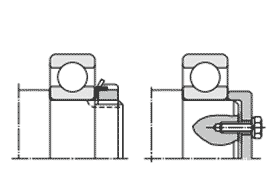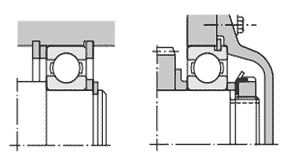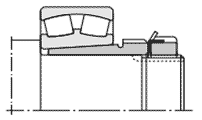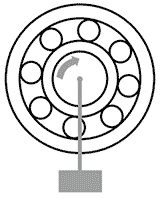Generally speaking, a bearing is only as good as its environment. Who can perform at their best if they don’t feel comfortable in their surroundings? Have you already read our article on fixed and floating bearings? This chapter provides a good basis for bearing mounting and surrounding component design.
Shaft and housing design
After the correct bearings and bearing arrangement have been selected, the surroundings must now be considered. The most important criteria that need to be taken into account are listed below.
- Selection of the bearing arrangement
- Correct bearing mounting
- Ensuring the mountability of the bearing (Important if you don’t want to make enemies during mounting).
- Choosing the right fit
- Determination of the correct bearing abutment dimensions (shoulder heights and corner radii)
- Geometric accuracy of shaft and housing (Attention: The more accurate, the higher the costs!)
- Determination of the maximum bearing misalignment in comparison to the permissible misalignment
At all times, the rolling bearing manufacturer’s specifications should be observed with regard to these criteria.
Securing of rolling bearings with mechanical elements
Information on choosing the right bearing arrangement can be found in the corresponding article. Let’s start with the correct mounting of the bearings on the shaft and in the housing. Rolling bearings can be secured with the help of various mechanical elements, including, for example, the use of lock nuts or retaining bolts or the use of a retaining ring (snap ring). For bearings with tapered bores, other bearing-specific accessories such as adapter sleeves and withdrawal sleeves can be used.
| Inner ring lock | Outer ring lock | Snap ring |
 |  |  |
| Rolling bearings can be fixed with the help of lock nuts or retaining bolts. | Above is a classic fastening with lock nut, lock washer, snap ring, bearing cover and spacer ring. | |
In this table you will see the fastening methods of rolling bearings that are generally in use.
With regard to the use of a retaining ring (snap ring), special attention must be paid to potential sources of error such as limit radii and bearing connection dimensions. Circlips simplify the construction. It is also important to know that retaining rings (snap rings) have certain disadvantages. They are not suitable for precision applications and equally unsuitable for absorbing high axial loads.
| Mounting with adapter sleeve | Mounting with withdrawal sleeve | Mounting with tapered shaft |
 |  |  |
| Adapter sleeves and withdrawal sleeves are used for axial location of the bearing on cylindrical shafts. | A split ring inserted into a groove on the shaft holds the rolling bearing in position with a split ring nut. | |
Further mounting options for rolling bearings are shown here for you.
The adapter sleeve is fixed by the frictional force between the shaft and the inner diameter of the sleeve. In addition, the position of the bearing on a cylindrical shaft can be freely selected when mounting with an adapter sleeve or withdrawal sleeve; both mounting variants are considered simple and process-safe. Mounting bearings with a tapered shaft is also an option. In this case, the split retaining ring is secured with a locknut or screw. The bearings (such as the spherical roller bearing in the illustration) can also be mounted easily and reliably by hydraulic means. According to the manufacturer’s instructions, the displacement path must be measured and, at the same time, always checked, just like the bearing clearance.
Selection of the correct tolerances for shaft and housing
After this brief overview of the various fixing options, we now come to the importance of tolerances for the shaft and housing. On the subject of bearing clearance and preload, terms such as bearing clearance and operating clearance have already been mentioned and it has also been explained how to calculate them. This chapter is now about choosing the right fits. The choice of the “right” fit depends on the following considerations:
- Shaft and housing material
- Wall thickness
- Surface texture
- Operating conditions of the machine
So, let’s get straight to the first important question: Tight fit or loose fit?
| Load visualisation | Bearing ring rotation | Bearing ring load | Bearing seat fit |
Fixed load
|
Inner ring rotates Outer ring static | Circumferential load for the inner ring Point load for the outer ring | Inner ring: Tight fit Outer ring: Loose fit |
Circulating load
|
Inner ring static Outer ring rotates | ||
Fixed load
|
Inner ring static Outer ring rotates | Point load for the inner ring Circumferential load for the outer ring | Inner ring: Loose fit Outer ring: Tight fit |
Circulating load
|
Inner ring rotates Outer ring static |
This table shows you under what circumstances a fixed or loose fit is necessary.
First it has to be clarified which of the two rings is rotating and which is static. Then it is checked which load is applied to the inner ring and which to the outer ring. An example: For the bearing unit shown, the fits for the two roller bearings are to be selected. Finally, the pulley is mounted on the shaft. The two bearings in question are a 6320C4 and a 6318C4 (manufacturer NTN).

Which ring rotates? Correct, both inner rings. The outer rings, on the other hand, should not rotate. Does the inner ring have a point load? No, it has a circumferential load. Circumferential load means that the direction of the radial load acting on the inner ring is circumferential for the ring. Point load is present on both outer rings and means that the load only acts on a small point of the outer ring. The recommended fit is therefore: Inner ring = tight fit and outer ring = loose fit. Suggestions for suitable fits can be found in the catalogues of the rolling bearing manufacturers, for example at NTN. For the current case, for example, taking into account a “normal load“, both shaft seats should have a k5 tolerance and an H7 tolerance should be selected for the housing seats.
Meaning of the bearing abutment dimensions
In addition to the bearing mounting itself, attention to the bearing abutment dimensions is crucial, with the shoulder height and corner radii playing a particularly important role.
It is important that the height h of the bearing ring against the shaft and housing (left side of the illustration) is greater than the maximum permissible edge radius rs max of the bearing (right side of the illustration). Otherwise, the support of the bearing on the shaft and housing is not sufficient. It must also be taken into account that the fillet radius ra has a smaller value than the smallest permissible edge radius of the rolling bearing rs min.
There are situations in which the corner radius ra max is larger than the edge radii of the bearing. Among other things, this occurs when the shaft is to be strengthened or the contact height is not sufficient as a support surface for the bearing. In such cases it is appropriate to use spacer rings. Spacer rings are individually manufactured in such a way that correct contact between the ring and the rolling bearing on the shoulder of the shaft or housing is guaranteed.


When using thrust bearings, it must be ensured that the supporting surfaces of the bearing rings are sufficiently wide, taking into account the criteria of load and rigidity. For this purpose, there are corresponding dimension tables, for example, in NTN’s catalogue.
Accuracy of the shaft and housing bearing seats
Another key area for design of surrounding parts is the accuracy of the mating surfaces for the shaft and housing. In addition, the surface roughness and the perpendicularity of the bearing shoulders are taken into account.
| Property | Shaft | Housing | |
| Dimensional accuracy | IT6 (IT5) | IT7 (IT5) | |
Roundness (max.) Cylindricity | IT3 | IT4 | |
| Abutment squareness | IT3 | IT3 | |
Fitting surface roughness Ra | Small bearings | 0,8 µm | 1,6 µm |
| Medium ~ large bearings | 1,6 µm | 3,2 µm | |
In the table you will find useful specifications regarding shaft and housing tolerances. This table applies to normal operating conditions. (IT = basic tolerances).
Permitted inclination and misalignment
Shaft deflections, deviations in the finishing of shaft and housing as well as the smallest installation errors lead to a certain misalignment between the inner and outer ring of a rolling bearing. It is therefore important that in applications where misalignments can be comparatively high, adjustable-angle bearings such as self-aligning ball bearings, spherical roller bearings or insert bearings are used. Basically, it should be noted that the permissible misalignment depends on factors such as the bearing type, load conditions and operating clearance and thus varies depending on the application. The specified guide values should not be exceeded, otherwise there is a risk of bearing damage or problems with the cage.
| Allowable bearing misalignment | |||
| Deep groove ball bearing | 1/1 000 ~ 1/300 | Tapered roller bearing: Single-row (standard) Single-row (Ultage) | 0 1/2 000 1/600 |
Angular contact ball bearing Single-row | 1/1 000 | Needle bearing | 1/2 000 |
Cylindrical roller bearing Bearing series 10, 2, 3, 4 Bearing series 22, 23 Ultage Double-row | 0 1/1 000 1/2 000 1/500 1/2 000 | ||
The permissible misalignment of various types of rolling bearings.
| Permissible bearing inclination | |||
Self-aligning ball bearing Normal load | 0 1/15 | Thrust spherical roller bearing Normal load | 0 1/60 to 1/30 |
Spherical roller bearing Normal load or more Light load | 1/115 1/30 | Insert bearing | 1/60 to 1/30 |
Self aligning bearings are used in applications with relatively high misalignments.
You may also be interested in
Bearing clearance, operating clearance and preload
Bearing clearance and operating clearance, isn’t that the same thing? And preload, I’ve heard that before, but what is that supposed to be?! How do
Fixed and floating bearings
Do I choose a fixed bearing arrangement, an adjusted bearing arrangement or a floating bearing arrangement? This question is important when designing a shaft system.
Lifetime calculation
Damn, bearing damage! If you consider that rolling bearings are exposed to continuous pressure and shear stress, this is nothing unusual to begin with. What
O, X and tandem arrangement
If you have already read the articles on angular contact ball bearings or tapered roller bearings, you may already have come into contact with different
Point and line contact
What is meant by “point and line contact”? You may have already heard that rolling bearings can be split into two types. The classification depends
Sealing
During the design of a bearing assembly, the topic of sealing will always accompany you. In the following material, we will cover both integrated and












